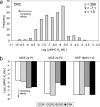Effect of multiple genetic polymorphisms on antigen presentation and susceptibility to Mycobacterium tuberculosis infection
- PMID: 18443099
- PMCID: PMC2446740
- DOI: 10.1128/IAI.01677-07
Effect of multiple genetic polymorphisms on antigen presentation and susceptibility to Mycobacterium tuberculosis infection
Abstract
Several molecules related to antigen presentation, including gamma interferon (IFN-gamma) and the major histocompatibility complex (MHC), are encoded by polymorphic genes. Some polymorphisms were found to affect susceptibility to tuberculosis (TB) when they were considered singly in epidemiological studies, but how multiple polymorphisms interact to determine susceptibility to TB in an individual remains an open question. We hypothesized that polymorphisms in some genes may counteract or intensify the effects of polymorphisms in other genes. For example, an increase in IFN-gamma expression may counteract the weak binding that a particular MHC variant displays for a peptide from Mycobacterium tuberculosis to establish the same T-cell response as another, more strongly binding MHC variant. To test this hypothesis, we developed a mathematical model of antigen presentation based on experimental data for the known effects of genetic polymorphisms and simulated time courses when multiple polymorphisms were present. We found that polymorphisms in different genes could affect antigen presentation to the same extent and therefore compensate for each other. Furthermore, we defined the conditions under which such relationships could exist. For example, increased IFN-gamma expression compensated for decreased peptide-MHC affinity in the model only above a certain threshold of expression. Below this threshold, changes in IFN-gamma expression were ineffectual compared to changes in peptide-MHC affinity. The finding that polymorphisms exhibit such relationships could explain discrepancies in the epidemiological literature, where some polymorphisms have been inconsistently associated with susceptibility to TB. Furthermore, the model allows polymorphisms to be ranked by effect, providing a new tool for designing association studies.
Figures






Similar articles
-
Multiple mechanisms allow Mycobacterium tuberculosis to continuously inhibit MHC class II-mediated antigen presentation by macrophages.Proc Natl Acad Sci U S A. 2005 Mar 22;102(12):4530-5. doi: 10.1073/pnas.0500362102. Epub 2005 Mar 14. Proc Natl Acad Sci U S A. 2005. PMID: 15767567 Free PMC article.
-
Prolonged toll-like receptor signaling by Mycobacterium tuberculosis and its 19-kilodalton lipoprotein inhibits gamma interferon-induced regulation of selected genes in macrophages.Infect Immun. 2004 Nov;72(11):6603-14. doi: 10.1128/IAI.72.11.6603-6614.2004. Infect Immun. 2004. PMID: 15501793 Free PMC article.
-
Effects of C2ta genetic polymorphisms on MHC class II expression and autoimmune diseases.Immunology. 2017 Apr;150(4):408-417. doi: 10.1111/imm.12692. Epub 2016 Dec 22. Immunology. 2017. PMID: 27861821 Free PMC article.
-
Regulation of antigen presentation by Mycobacterium tuberculosis: a role for Toll-like receptors.Nat Rev Microbiol. 2010 Apr;8(4):296-307. doi: 10.1038/nrmicro2321. Nat Rev Microbiol. 2010. PMID: 20234378 Free PMC article. Review.
-
Expression level of risk genes of MHC class II is a susceptibility factor for autoimmunity: New insights.J Autoimmun. 2018 May;89:1-10. doi: 10.1016/j.jaut.2017.12.016. Epub 2018 Jan 10. J Autoimmun. 2018. PMID: 29331322 Review.
Cited by
-
Mathematical and computational approaches can complement experimental studies of host-pathogen interactions.Cell Microbiol. 2009 Apr;11(4):531-9. doi: 10.1111/j.1462-5822.2008.01281.x. Cell Microbiol. 2009. PMID: 19134115 Free PMC article. Review.
-
Mice expressing human ERAP1 variants associated with ankylosing spondylitis have altered T-cell repertoires and NK cell functions, as well as increased in utero and perinatal mortality.Int Immunol. 2017 Jun 1;29(6):277-289. doi: 10.1093/intimm/dxx035. Int Immunol. 2017. PMID: 28814066 Free PMC article.
-
A multifaceted approach to modeling the immune response in tuberculosis.Wiley Interdiscip Rev Syst Biol Med. 2011 Jul-Aug;3(4):479-89. doi: 10.1002/wsbm.131. Epub 2010 Dec 31. Wiley Interdiscip Rev Syst Biol Med. 2011. PMID: 21197656 Free PMC article. Review.
-
Characterizing the dynamics of CD4+ T cell priming within a lymph node.J Immunol. 2010 Mar 15;184(6):2873-85. doi: 10.4049/jimmunol.0903117. Epub 2010 Feb 12. J Immunol. 2010. PMID: 20154206 Free PMC article.
-
Heterozygosity at the A625C polymorphic site of the MyD88 gene is associated with Mycobacterium bovis infection in cattle.Infect Immun. 2013 Jun;81(6):2139-44. doi: 10.1128/IAI.01398-12. Epub 2013 Apr 1. Infect Immun. 2013. PMID: 23545302 Free PMC article.
References
-
- Agrawal, N. G., and J. J. Linderman. 1996. Mathematical modeling of helper T lymphocyte/antigen-presenting cell interactions: analysis of methods for modifying antigen processing and presentation. J. Theor. Biol. 182487-504. - PubMed
-
- Alcais, A., N. Remus, L. Abel, and J. L. Casanova. 2001. Genetic susceptibility to tuberculosis: from monogenic to polygenic inheritance. Sepsis 4237-246.
-
- Bellamy, R. 2005. Genetic susceptibility to tuberculosis. Clin. Chest Med. 26233-246. - PubMed
-
- Blower, S. M., and H. Dowlatabadi. 1994. Sensitivity and uncertainty analysis of complex models of disease transmission: an HIV model, as an example. Int. Stat. Rev. 2229-243.
Publication types
MeSH terms
Substances
Grants and funding
LinkOut - more resources
Full Text Sources
Medical
Research Materials

